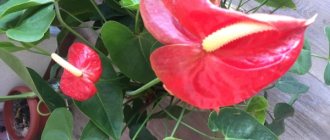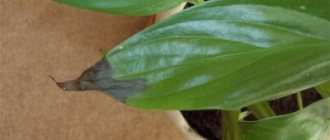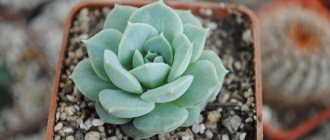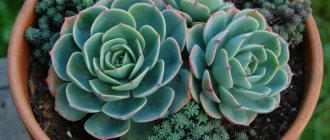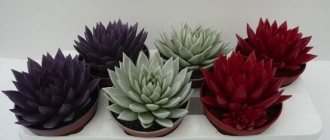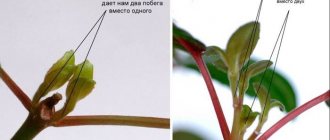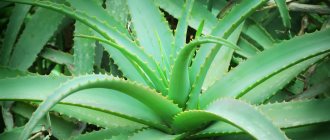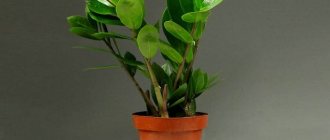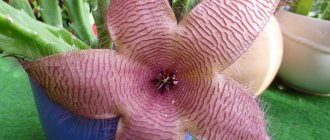Botanical description of the plant with photo
Echeveria or Echeveria is a succulent plant belonging to the Crassulaceae family.
The perennial has several distinctive features:
- may be stemless or have a stem reaching a height of 70 cm;
- some species are distinguished by creeping shoots;
- the root system is not buried, but grows superficially;
- in most species, the leaves are quite dense, hard, saturated with moisture, because of this the plant gives the impression of being made of stone;
- the leaf plates are oval in shape with a pointed tip, their length reaches 30 cm, width - 15 cm;
- the color of the leaves is quite varied: violet-pink, wine-red, gray with a blue tint, all shades of green;
- there is pubescence on the leaf blades or a coating similar to frozen wax;
- the rosette in which the leaves are collected can be dense or loose;
- The peduncle can be lateral or vertical and reach a height of up to 50 cm;
- the color of the peduncle depends on the light: in bright light it is red-orange, in dim light it is yellow;
- the flowers are small (up to 30 mm) five-membered bells, collected in erect inflorescences.
Description and characteristics
Names: what are they called and why?
The genus was named after the Mexican artist Atanasio Echeverría y Godoy, who illustrated books on the flora of Mexico and was the first to describe an exotic plant with fleshy, dense leaves collected in a rosette. Therefore, abroad the plant is called “echeveria”, after the artist’s surname, but in Russia and the CIS countries they use the more familiar version “echeveria”. The leaf plates of the plant are so saturated with moisture that they are as hard as stone, which is why echeveria is popularly called “stone flower” and “stone rose”.
Sometimes echeveria is called “juvenile” because of its external resemblance to the plant of the same name, but these are two different flowers, the differences of which will be discussed below in the corresponding section.
Botanical characteristics
| Domain | Eukaryotes |
| Kingdom | Plants |
| Department | Flowering |
| Class | Dicotyledons |
| Order | Saxifragaceae |
| Family | Crassulaceae |
| Genus | Echeveria (echeveria) |
| Prevalence | Mexico, USA (from Texas to California), Southern Peru, Caucasus Mountains. |
Indoor varieties of echeveria
Of the 200 existing species of echeveria, a sufficient portion of them grow well at home. Most Popular:
- agave;
- hump-flowered;
- The Pearl of Nuremberg;
- bristly;
- Lau et al.
They all differ in botanical characteristics and color, so many gardeners prefer to grow several varieties at the same time.
Find more information about varieties and hybrid varieties of the plant here.
Florarium decoration
A beautiful and original composition can be created using several miniature succulents in a florarium.
It can be created independently or purchased ready-made. The composition can be composed of various types of echeveria, cacti, Kalanchoe, young plants and other plants. Work on creating a composition is carried out in the following order:
- First, the glass container is disinfected with alcohol.
- Fine drainage is poured onto the bottom of the container in a layer a quarter of its height, on top - a layer of soil of the same thickness, lightly compact both layers.
- It is imperative to have a drainage layer at the bottom of the container, even if it is small and small plants are planted.
- Next, plants are placed on the ground, the roots of which are lightly sprinkled with soil, which is carefully compacted.
- Pre-boiled and cooled decorative pebbles and sand are laid out on the ground (colored sand will look more beautiful). You can also put special stones for the aquarium.
- If the top layer of the florarium will be soil for the aquarium, it is better to use colored soil - it will turn out very beautiful.
- All that remains is to decorate the composition by installing figurines or floral decorative elements.
Decorating a florarium using a stone rose.
The place for the florarium should be brightly lit. The composition should be watered rarely, even less often than an echeveria growing in an open pot is watered; the soil should not become waterlogged.
Temperature
Echeveria is a heat-loving plant that thrives even in very hot conditions. During its growth period, room temperature is recommended. Since the flower loves daily temperature changes, the appropriate indicator for it in the daytime is from +22 to +26 °C, at night - from +10 to +16 °C.
In winter, the air temperature in the room with echeveria should be no higher than +13 °C and no lower than +7 °C.
Wintering in cool and dry conditions will have a beneficial effect on bud formation. Otherwise, the absence of a dormant period will significantly weaken the plant.
Flowering and dormant periods
Juveniles do not have a dormant period, they always bloom, it’s just that development slows down in winter.
In order to bring the flower to life, you need to leave it alone in a cool room. The crop blooms in most cases in the summer.
A beautiful earth rose produces one or more flowers. If the owner of the succulent does not plan to propagate the crop by seeds, then the flowers must be removed, otherwise the rose will begin to deplete.
Stone rose bloom
How often and correctly to water?
Echeveria tolerates drought conditions well and does not like even slight waterlogging of the soil. Therefore, watering is permissible only after the earthen clod has thoroughly dried to 1/3 of its depth. Excess moisture that appears in the pan is immediately removed.
Recommended frequency:
- in spring and summer – once a week;
- in autumn and winter - once a month.
For irrigation, use well-settled or rainwater.
To avoid moisture getting on the leaves, leading to rotting, this procedure is carried out using a watering can with an elongated spout.
Home care
Echeveria is an unpretentious plant that needs only good lighting and rare fertilizing. By following simple tips, you can grow this flower, even if you have never had such experience before.
Location and lighting
Stone rose is a native of deserts and semi-deserts; the plant is not afraid of direct sunlight and needs good lighting.
In the yard, this species is planted in sunny flowerbeds, away from bushes, trees and buildings - strong shading leads to a strong elongation of the rosette in height and to a delay or absence of flowering. Indoors, the pot is placed on a south or southeast window sill. It is important to monitor the length of daylight hours (10-12 hours) . In the warm season, echeveria is taken out onto the balcony or into the yard, providing it with protection from rain and wind.
Content temperature
Echeveria is a heat-loving plant, so in summer the optimal temperature is +20...+27 degrees, and in winter +10...+15. The temperature should not be allowed to drop below +6 degrees, otherwise the plant will get frostbite and die. Species whose flowering period occurs in winter are kept at +18...+20.
The leaves of the stone rose are very sensitive to cold and frost, because of which the rosette loses its attractive appearance, the leaves become asymmetrical and wither. Therefore, when ventilating, the plant is protected from cold air currents. You can use a heater, but it is better to keep it away from the flower.
How to care during the dormant period?
The dormant period of the stone flower occurs in the cold season (late October-February). A few simple rules are followed:
- 12-hour daylight using lamps;
- temperature range +8…+15 degrees;
- watering once a month.
With the onset of spring, watering is increased, fertilizer is added, and if necessary, replanting or pruning is done.
IMPORTANT ! Fertilizer is applied either a few weeks before transplantation, or 2 months after.
Watering
The plant loves moderate and scanty watering. Water the echeveria with rain or water that has stood for several days at room temperature. In summer, the soil is moistened once a week after the top layer has dried by 3-5 cm, and in winter, watering is done no more than once a month
IMPORTANT ! Do not allow moisture to stagnate at the roots and especially inside the outlet! Watering is done either through a tray, draining the remaining water after a while, or by drip to the very root.
Humidity
Like all succulents, echeveria feels comfortable in low air humidity and is not afraid of the close proximity of heating devices. It stores moisture in its leaves, so increased humidity levels will only weaken the plant’s immunity and cause diseases.
The soil
The soil for stone roses is low-nutrient, loose, with neutral acidity. You can prepare the soil mixture yourself using the following recipes:
- mix part of leaf and part of turf soil with two parts of river sand;
- add part loam and part peat to two parts coarse sand.
Self-prepared soil should be disinfected by adding a small amount of charcoal to prevent root rot.
A drainage layer (1/3 of the volume) is laid out at the bottom of the pot. Expanded clay, pebbles, brick chips or small clay shards are used.
Purchased soil for succulents, which are sold in specialized stores, is also suitable. For example:
- Gera biosoil for cacti and succulents. A pack contains 2.5 liters, peat-based soil with the addition of sapropel. Price – from 185 rubles;
- ZeoFlora soil for cacti and succulents, moisture-regulating, 2.5 l. Price – from 320 rubles;
- Fusco soil “Flower Happiness” for cacti, peat-based, 2.5 l. Price – 66 rub.
- Soil Garden of Miracles “Cactus”, peat-based, with vermicompost, 2.5 l. Price – 67 rub.
Purchased soil needs improved aeration, so coarse sand or brick chips are added to it. Select those producers who use high peat soil in the soil composition - it is light and loose. If the package indicates high acidity levels, add a handful of dolomite flour to the soil.
Pot
Due to its shallow root system, echeveria is planted in a wide, but not deep, clay or ceramic pot. Choose a light color scheme so that the walls do not get too hot in the sun. Be sure to use a tray. Many owners of this plant plant echeveria in pots, especially species with long, hanging stems.
ATTENTION ! Echeveria is often planted in large glass glasses, aquariums, florariums, and ceramic bowls to enhance the decorative effect. Such containers do not have holes for draining water, so watering is done rarely, creating desert conditions.
Feeding and fertilizers
Nitrogen fertilizers and humus are not used when growing echeveria. She, like other succulents, is accustomed to slow growth. These fertilizers stimulate growth, causing the surface of the leaves to crack, which causes a weakened immune system and the development of diseases.
It is enough to apply complex fertilizer for succulents and cacti once a month in spring and summer, using half the dose:
- complex fertilizer House of Bion “Cactus”, 21 rubles for 25 g;
- fertilizer for cacti UltraEffect Classic, 280 rubles per 250 g;
- Agricola fertilizer for cacti and succulents, 25 g for 22 rubles.
Trimming
Echeveria does not require formative pruning. To preserve the decorative appearance of the plant, dried lower leaves are regularly removed.
If the rosette has grown in length, cut off the top, leaving a stump of 3-4 cm. This will start the growth of new shoots.
Spraying
The plant does not need spraying or any other air humidification. Moreover, drops of water collected at the roots and traveling down the leaves can cause them to rot or become infected with pests and fungal diseases.
Care for the first time after purchase
Having bought echeveria at the market or in a store and brought it home, first of all, provide the new flower with a quarantine zone for at least 2 weeks. This is done in order to protect the remaining flowers from possible diseases or pests.
Provide the new tenant with good lighting . If the purchase happened in spring or summer, replant the plant in new soil. In winter, it is better to refrain from such a procedure.
After 2 weeks of quarantine, the pot with the stone rose can be placed on the windowsill with the rest of its inhabitants. It is better to choose low-growing plants for neighbors so that the shadow does not fall on the echeveria.
What kind of pot is needed to grow a flower?
The container for planting echeveria should be 1.5-2 cm larger than the diameter of the plant itself and have drainage holes. Due to the shallow root system, a low and at the same time wide pot would be an ideal option.
Experienced flower growers recommend purchasing ceramic or clay containers that allow moisture and air to pass through perfectly. When giving preference to plastic products, it is worth remembering their ability to heat up quickly, which negatively affects the condition of the root system.
Propagation of stone flower by daughter rosettes
In this simple way you can propagate any species, just pick up sharp scissors.
When is it produced?
The best time to cut shoots is the second half of May. At this time, the succulent has recovered from wintering and is ready for active growth.
Detailed description
The procedure is simple:
- Young rosettes more than 2 cm in diameter are cut off.
- If the species forms rosettes on long shoots, then leave a piece no more than 1-2 cm long.
- The cut rosette is immediately buried in the selected area or planted in a pot no more than 5 cm in diameter.
Priming
Echeveria prefers loose soils with little nutritional value. For planting, you can purchase an industrial composition for succulents or prepare the substrate yourself.
It is recommended to add fine brick chips and river sand to store-bought soil, and crushed charcoal to prevent root rot.
To prepare your own substrate you will need:
- turf soil - 1 part;
- dry clay – 1 part;
- coarse sand – 1 part;
- leaf soil - 2 parts;
- drainage.
Similar plants
Due to its external similarity, echeveria is often confused with another succulent plant - juveniles. Remember that echeveria is grown as a home ornamental plant and should not be left to overwinter in open ground. But the young ones are not afraid of frost and feel great outside. Echeveria grows in loamy soil with the addition of sand, and the young ones need soil with compost and humus.
Stone rose is an exotic flower that will become an unusual decoration for your windowsill. Echeveria does not require careful care and can do without attention for 2-3 weeks if it is watered first. At the same time, the plant has strong immunity, it rarely gets sick and gets along well with other neighbors.
Transplantation after purchase and more
Young plants (under 3 years of age) are replanted once a year, and subsequently once every 3-4 years. The optimal time for this event is spring.
The process includes several stages:
- Place a layer of drainage at the bottom of the prepared container; for this purpose, you can use broken brick, expanded clay or crushed clay shards.
- Fill the drainage layer with substrate and place the flower in the center of the pot.
- Sprinkle fresh soil around the perimeter of the plant, using your fingers to remove any air pockets that form.
- At the final stage, surround the root collar of the echeveria with small pebbles or a layer of coarse river sand to improve the outflow of moisture.
Leave the transplanted plant for 7-10 days in a shaded place.
Transfer
It will most easily withstand the stress of replanting in the spring, growth will quickly resume, and flowering will occur in due time. For the first two to three years, the plant is replanted annually, then every three to four years, but observing the rule of annual replacement of the top layer of soil.
When necessary, desirable and undesirable
An adult plant is transplanted if the echeveria grows and becomes crowded in its original pot. You cannot replant a flower during periods of flowering or dormancy, as well as during the cold season . Sometimes transplantation is carried out in order to cure the plant from fungal diseases.
Requirements for soil and pot
The pot is chosen a little larger than it was before, made of clay or ceramic, with holes for draining water. A drainage layer is poured below (pebbles, expanded clay, brick chips), loose soil is selected, with the addition of sand (according to the recipes given above), or using purchased soil for cacti and succulents.
Step-by-step instruction
The transplant process is simple:
- Prepare the pot, add drainage and soil.
- Make a small depression in the soil (no more than 2-3 cm in depth), slightly larger in size than the root system of the flower.
- Remove the echeveria from the old pot. Be careful not to damage the rosette or roots.
- If the plant is sick, carefully clean the roots from the old soil. Healthy echeveria is transplanted with a dry clod of earth. To do this, reduce watering before transplanting.
- Place the echeveria in the hole, sprinkle the roots with soil and press it lightly with the palm of your hand.
- Water the flower through the tray, let the roots soak in moisture and drain off excess water, and then put the pot back in its original place.
Reproduction
In indoor conditions, echeveria can be propagated in almost all available ways.
Sowing seeds
The process of growing from seeds is considered the longest, as it takes up to 3 months.
Seeds for sowing can be purchased at the store or collected yourself. They are scattered over the surface of a flat container filled with a mixture of peat and sand (1:1), lightly pressed down and moistened with a spray bottle. Cover the top with plastic film or glass.
For 15-20 days it is necessary to maintain temperatures of about 25 degrees. When the seeds germinate, the film is removed. The seedlings are transplanted after 2-3 months.
Leaf
Algorithm of actions:
- Cut off a healthy leaf.
- Dry: 14-20 days for a fleshy plate, 2-3 hours for a thin specimen.
- Press the sheet with the cut inward onto the prepared soil.
- Moisten with a spray bottle and cover with film.
- Maintain the temperature in the greenhouse at +25 °C.
As a rule, when breeding using this technology, babies appear in 2-3 weeks.
Rosettes
This method is considered the most effective - echeveria throws out the first flower stalks within a year. Replanting a rooted rosette is recommended after 2 months, or within a year in case of slow plant growth. The algorithm of actions is the same as when rooting a leaf.
How to root with the top?
Typically, rooting with apical cuttings is carried out after the lower leaves have completely fallen off, as a result of which the plant becomes inconspicuous. The planting method is identical to leaf planting. When propagated in this way, the cuttings buried in the soil begin to grow in about 20 days.
Types and classification
At the moment, more than 200 species of this plant are known. The systematization of Echeveria species is quite extensive. The varieties of this plant are divided according to the following criteria:
- by structure – dense or loose rosette;
- by the color of the plates - the leaves of the hybrids are characterized by different colors, there are all shades of green, pink, lilac, yellow, purple, red;
- according to the root system - the roots of the plant are both superficial and thread-like;
- along the stem - there are varieties with a rosette growing from the soil, or creeping when it rises above the ground;
- by the color of the leaves under special lighting - red or yellow.
Agave echeveria (Echeveria Agavoides)
A bushy flower native to Mexico. It has almost no stem, the leaf blades are ellipsoidal, light green with silver. Large rosettes, up to 30 cm. Blooms with red or yellow bells.
Echeveria shaviana (Echeveria shaviana)
The rosette of Chauviana looks like a loose head of cabbage with gray-blue leaves wavy at the edges. In winter, the flower sheds most of its leaf plates. In June, 2-3 peduncles are thrown out, which begin to bloom alternately.
Echeveria Affinis "Black Knight"
Large rosettes with leaves of green and black, turning into purple pointed tips. The upper side is without bends, almost flat. With a lack of lighting, the foliage loses its dark color, becomes greener, and begins to stretch out.
Echeveria pulvinata
It grows only up to 10 cm in height. The oval leaves (ovate-shaped) with a spine at the top have a curved shape and a velvet edge. Blooms with yellow-red bells in early spring.
Elegant echeveria (Echeveria Elegans)
It has practically no stem. The rosette is lotus-shaped, with dense fleshy leaves. The bluish coating on the light green leaves performs a protective function and cannot be removed. Over time, the shoots become creeping and take root. The peduncle is vertical, with inflorescences of pink-red bells, the border of which is yellow.
Echeveria Amoena
A rare species with flat shoots and many branches. The leaves are small, bluish, triangular in shape. Flowers in yellow and red colors.
Echeveria Derenbergii
A popular species with bladed leaves of gray-green color, the edges of which are pink. Shoots creep along the ground. In March-April it produces flower stalks up to 5 cm long, on which 3-5 spike-like yellow-orange flowers bloom.
Desmeta (Echeveria desmetiana)
A dense rosette with blue leaves that become ampelous with age. In early July, yellow-orange flowers appear on the side. The species tolerates shade well.
Echeveria Gibbiflora
It is one large rosette with a tree-like stem and rounded leaves of light green color. There are irregularly shaped new growths on the surface of the leaf blade. Blooms with yellow or orange bells.
Nodulose (Echeveria nodulosa)
This species is also called nodular echeveria. The height of the flower reaches 50 cm, the rosette is loose, with obovate leaves. Their shade is bright green with a burgundy web pattern. It begins to bloom in late spring, the petals of the bells are scarlet-brown.
Metal-flowered echeveria (Echeveria metallica)
A shrub 30-40 cm high, with a loose rosette, the leaf blades of which are reddish on the outside and yellow on the inside.
Echeveria Glauca
A dense rosette with bluish leaves with a bluish tint. tone with a bluish tint. There is practically no stem. In winter, a pink edging forms along the edges of the leaf blades. Flowering begins in spring, when echeveria produces an arrow with yellow buds.
Echeveria Lauii
A species with small leaves covered with a waxy coating. The dense rosette reaches 20 cm. The flowers are yellow or orange, matte due to a thin layer of wax.
Echeveria Pulidonis
The rosette of the flower reaches 15 cm in diameter. The foliage is curved, elongated, narrow, up to 6-7 cm, blue with a pink border. The stem is missing. Blooms in summer with yellow bell buds.
brilliant echeveria
Grows as a small bush. Thick shoots extend from the main rosette, on which smaller rosettes form. The light green leaves have a waxy edge along the edges. Flowering occurs in February-March, the petals of the flowers are bright red.
Echeveria Lilacina
Belongs to a slow growing variety. The leaves are dense, hard and thick. The size of the rosette is 25 cm, the shade of the plates varies from bluish-gray to lilac. The buds are soft coral or pink. They are formed on arching reddish fifteen-centimeter arrows. Flowering occurs from the end of February to the last days of May. If a flower is placed in the sun, a waxy coating forms on the foliage, turning the leaves white.
Bristle echeveria (Echeveria setosa)
The rosette of this species is very similar to a chrysanthemum and grows up to 15 cm. The leaves are fleshy and lanceolate, green in color. Their entire surface is strewn with white fibers. The stem is up to 10 cm long, the peduncle is also covered with growth. It blooms in early summer, the color of the bells is similar to a bonfire - a mixture of orange and red.
Echeveria Black Prince
A variety of humpback-flowered echeveria. Prince's leaf blades are greenish at the base and almost black throughout the rest of the surface. The rosette is fleshy, dense, up to 15 cm in diameter. Produces a dark stalk with orange or reddish-brown buds.
Echeveria Miranda
Hybrid variety. The rosette is large, similar to a lotus flower with green petals, the tips of which are painted burgundy. In some varieties, the color of the leaves is completely burgundy, lilac, yellow, pink, and silver. Miranda is most often used when making florariums.
Echeveria Pearl of Nuremberg (Echeveria Perle von Nurnberg)
Hybrid. It has a straight and thick stem, the leaves are scarlet or pinkish-lilac. It blooms closer to summer, in outdoor conditions, producing scarlet bell flowers.
Echeveria purpusorum or Crimson (Echeveria purpusorum)
The plant is compact in height and width. Its maximum dimensions are 10 by 8 cm. The species has an unusual structure of the leaf plate - it is triangular in shape with a rigid structure with a peak-like tip. The color of the leaves is olive or marshy, with many small patches of brown. In May, the bush produces an arrow, 20 cm in height, on which red buds with an orange tint are formed.
Echeveria Cubic Frost
The leaves of this species grow with the narrow part down. They are light green in color, collected in a dense fleshy rosette, vaguely shaped like a square.
Echeveria Pollux
White-blue color with a lilac sheen and flat, wide, pointed leaves. They form a star-shaped symmetrical rosette, reminiscent of an open flower.
Echeveria Agavoides Taurus
A variety of agave-like echeveria. The difference is the change in color of the leaf plates. As it ages, it changes from light green to burgundy-violet.
Echeveria mix
Echeveria mix is a combination of several species and varieties of a plant such as Echeveria. It looks most beautiful when flowers are selected that have different rosette shapes, leaf sizes and colors. They are usually collected in a florarium or other container.
FAQ
Are there non-flowering species?
With proper care, all types of echeveria produce flower stalks or arrows with inflorescences of 3-5 bells.
What species can be grown in the garden?
In the warm season, all types of this plant can be planted in open ground. However, echeveria is able to overwinter only in those regions where the temperature in the winter months does not drop below +6 degrees.
Is it possible to leave without care during the holidays?
Thanks to the unpretentiousness of the stone rose, you can safely leave it for 2-3 weeks of your vacation. To do this, leave the plant on a well-lit windowsill and moderately moisten the soil before leaving.
Is Echeveria annual or perennial?
Echeveria is a perennial plant that, with proper care, can live up to several decades.
Diseases and pests
Ignoring the rules of agricultural technology can cause the development of the following diseases:
- dry rot;
- root rot;
- powdery mildew.
When the first signs of disease are detected, the plant is treated with a fungicide.
Echeveria is susceptible to attacks from pests such as:
- root-knot nematode;
- root mealybug;
- mealybug.
To combat harmful insects, the flower is treated with an insecticide.
Benefits and harms
Among the beneficial properties of evergreen grass are:
Molodilo has a powerful anti-inflammatory, analgesic effect, and the ability to effectively heal external wounds and internal ulcers. This is an excellent antidote, which was consumed with wine back in Ancient Greece.
Stone rose is valued for its anti-scorbutic effect, which is especially important in the treatment of febrile conditions, ulcerative lesions, digestive tract disorders, and stomatitis. The flower is actively used by women during menstruation, which is accompanied by severe painful sensations.
A decoction based on molodil shows its effectiveness in the treatment of thrush in children and adults. Hare cabbage tincture is used for pathologies of the respiratory system and eyes. The succulent is also used as an anthelmintic plant. Due to its medicinal properties, there are recipes that allow you to use young milk to combat cardiovascular diseases.
Only leaf plates of the flower are used as raw materials for preparing decoctions and tinctures, since most of the beneficial components are concentrated in them.
A stone rose can bring not only benefits, but also harm to the body. Namely:
- There is a high probability of a severe allergic reaction.
- There is a risk of poisoning, but often such negative consequences occur in the event of an overdose.
Possible problems
Often the poor condition of echeveria is caused by non-compliance with the watering regime or improper lighting.
What to do if you are stretched out?
Stretching of a flower indicates a lack of sunlight. The problem can easily be eliminated by moving the pot to a more illuminated place.
Why did you lower the leaves down?
Drooping leaves that have lost their original elasticity indicate dehydration of the soil. In this case, the substrate must be moistened by adding liquid complex fertilizer to the water, and then strictly adhere to the watering regime.
Also, the reason for drooping leaves may be low room temperature or stagnation of water in the root system.
The lower plates fall off and turn yellow
Yellowing and falling of leaves is associated with stagnation of water in the pot. To eliminate the problem, it is recommended to completely replace the soil.
The socket is rotting: how to save it?
If the socket rots, first of all you need to give it a chance to dry. In the future, it is recommended to transplant the plant into another soil, cutting off the damaged lower leaves and fragments of the root system.
Errors when leaving
If the flower is not properly cared for, various diseases can develop. With a lack of lighting, the plant loses its aesthetics. If there is not enough sunlight, you should use phytolamps and use them to illuminate the plant.
If there is a lack of moisture, the leaves will begin to curl, then you need to water the flower. As the plant ages, the lower leaves begin to turn yellow - this is a natural process.
With excess moisture, the leaves become swollen and watery. If a lover of indoor plants notices these signs, you need to urgently inspect the roots and transplant the young plant into another pot and adjust the watering.
How to create a mix composition?
The process of creating a composition with echeveria includes several manipulations:
- Choose a suitable container.
- Lay out in successive layers:
- drainage expanded clay;
- soil diluted with vermiculite/perlite;
- moss.
- Arrange the succulent cuttings so that there is room for further growth.
- Lay out decorative elements: pebbles, shells, figurines, etc.
- Water without allowing water to get on the leaves of the plant.
When creating a mix composition, it is important to use succulents with similar habitat requirements.
Options for using stone roses in landscape design
Succulents can pleasantly diversify the look of a garden, adding zest and some warmth to it. The uniqueness of the plant lies in the fact that it is very beautiful, but at the same time it has a green or burgundy tint that is pleasant to the eye. It’s hard to overdo them, so they can be used in absolutely any volume.
- As already mentioned, echveria does not combine well with other flowers due to the fact that it does not receive enough light. Therefore, you need to carefully select other crops. It’s better to do without them, the stone rose is already quite original.
- The combination of pebbles (decorative stones) and hare cabbage is the most impressive. Tender and succulent succulents look very beautiful together with neutral and harsh gray-brown tones. Therefore, if you doubt your abilities as a decorator, choose young ones. It requires very little effort and material, and the result will be wonderful.
- Stone roses look great in individual pots. There is absolutely no need to buy new ones! Broken or outdated containers will do, as long as they are well cleaned. For beauty, you can paint “patches” in especially worn places. Place it on the ground side up and let your imagination run wild! Gardeners even use old shoes, and succulents look great in them.
Stone rose goes well in any composition. They can be used with anything (as long as they follow the prescribed rules).
Stone rose goes well in any composition
Growing a flower in open ground
Initially, young was an open ground plant, so it is freely grown in flower beds, rock gardens, alpine hills, and also in various flowerpots in the country.
How to plant a stone rose (seeds and vegetatively)
In open ground, sowing can be done when the soil warms up to 20 °C, only then after 14 days will seedlings appear. Since young seedlings are very small in size and grow extremely slowly, the seed method for open ground is rarely used, giving preference to cutting and planting daughter rosettes. Rooting usually takes only 2 weeks.
Stone rose seedlings
Note! The best time for sowing seeds is June, and for planting rosettes cut from an adult plant, late spring, all summer and even September are suitable
Selecting a location
The place for the stony rose should be illuminated throughout the day. It is best to choose an elevated site to eliminate the possibility of moisture accumulating at the roots.
How to prepare the soil and flower for planting
Loose soil containing little humus is suitable for planting. It is best to additionally add sand and crushed charcoal for better aeration. The sockets themselves do not require preliminary preparation.
Step by step landing procedure
The order of planting sockets is as follows:
- Using a sharp knife, cut the young rosettes from the mother plant, leaving a petiole 5-10 mm long.
- Immediately prepare the site for planting by thoroughly loosening the soil on it.
- Plant rosettes, leaving 10-15 cm between them.
- Water the rose stone very carefully to only slightly moisten the soil. The next watering is needed no earlier than 7 days later.
Original compositions
For lovers of minimalism, ensembles of different types of young flowers in an elegant amphora or large flower vessel will suit them.
For lovers of the East - a small garden in the same style, with boulders and possibly traditional figurines. This is a great option for relaxation.
To create an exotic atmosphere, also choose young ones, using them together with original containers: broken jugs, antique pots, worn amphorae, bright flowerpots, and even old shoes.
Stone rose combined with stone or concrete looks amazing. And in a flat vessel, small roses seem artificial, and there is a desire not only to admire them, but also to touch them.
Simple care and the original appearance of the young allow even a novice gardener to feel like the creator of unique landscape masterpieces, showing a flight of imagination and a little diligence.
Growing a flower in open ground
Initially, young was an open ground plant, so it is freely grown in flower beds, rock gardens, alpine hills, and also in various flowerpots in the country.
How to plant a stone rose (seeds and vegetatively)
In open ground, sowing can be done when the soil warms up to 20 °C, only then after 14 days will seedlings appear. Since young seedlings are very small in size and grow extremely slowly, the seed method for open ground is rarely used, giving preference to cutting and planting daughter rosettes. Rooting usually takes only 2 weeks.
Stone rose seedlings
Note! The best time for sowing seeds is June, and for planting rosettes cut from an adult plant, late spring, all summer and even September are suitable
Selecting a location
The place for the stony rose should be illuminated throughout the day. It is best to choose an elevated site to eliminate the possibility of moisture accumulating at the roots.
How to prepare the soil and flower for planting
Loose soil containing little humus is suitable for planting. It is best to additionally add sand and crushed charcoal for better aeration. The sockets themselves do not require preliminary preparation.
Step by step landing procedure
The order of planting sockets is as follows:
- Using a sharp knife, cut the young rosettes from the mother plant, leaving a petiole 5-10 mm long.
- Immediately prepare the site for planting by thoroughly loosening the soil on it.
- Plant rosettes, leaving 10-15 cm between them.
- Water the rose stone very carefully to only slightly moisten the soil. The next watering is needed no earlier than 7 days later.
How to make echeveria bloom
How echeveria blooms photo
The stone rose is ready to bloom at 2-3 years of age. In the hot and dry conditions of our apartments, echeverias bloom successfully on the windowsill. There are flower growers who do not like the flowering of echeverias; they prefer the decorative appearance of rosettes.
If you want to see flowers, but there are none, then you need to extend the daylight hours. Keeping echeveria for 45-60 days at 15-18 degrees of heat and light for 12-13 hours will give the desired result - buds will appear. Then turn up the watering a little and feed it with fertilizer for flowering plants.
In rutarium
Rutaria (from the English root) are garden compositions made from old tree trunks, stumps and snags that harmoniously fit into the landscape of the territory. The ability to occupy as much free space as possible with a variety of decorative elements, in this case exclusively natural, will help solve the problem of ensuring the safety of the root system of the young. At the same time, it is not necessary to plant the young directly into the ground. A composition in which the role of a pot for the young would be played by a stump or an unusually shaped piece of driftwood would look no less impressive and organic.
Watering
The rules for watering young plants are quite ordinary. Like all succulents, stone culture does not tolerate an abundance of moisture. It would be more correct to water it with bottom watering through a stand, so as not to wet the leaves. With this process, the roots will absorb as much water as they actually need.
The soil should dry out between waterings. But prolonged drought is also harmful to them - the leaves of the plant begin to wrinkle and lose turgor. You need to remember: the lower the temperature in the room, the less watering. For example, if a stone flower is in a cool room on a windowsill, watering should be kept to a minimum.
The air humidity itself is completely indifferent. In this regard, there is no need to spray the crop at all. Moistening the leaves is generally harmful for this species, and under the scorching sun the drops can cause burns. It is not advisable to wipe the leaves, as the flower loses its natural protective film.
Where does the stone flower plant grow? Many people already know the answer to this question. All that remains is to decide on the planting area and variety, and then you can admire this marvelous creature for a very long time!
Young: the most popular varieties
The rock rose belongs to the genus Crassulaceae, a family of succulents. All its types, and there are about thirty of them, are compact and unusually decorative. The flower grows in semicircular rosettes with fleshy leaves of different shades. In appearance, the plant itself looks like a bud of a blooming rose. Hence the name - stone rose. Why stone? The flower itself seems to be carved from precious green stone, and it grows best on rocky soils.
The following varieties are popular in our area:
- Roofing was rejuvenated.
This variety has large rosettes with oblong leaves, which are burgundy-colored at the tips. The most popular varieties are shown in the photo. - Wulfena.
The plant is compact and suitable for any place in your garden. The variety is valued for its delicate green leaves and beautiful lemon flowers. - The Russians were getting younger.
It can be found in forests, fields and hillsides. The leaves of the rosettes are thin, dark green, and the flower itself has a flat shape. It is very easy to place it in your garden. Just bring the plant from the forest with a small lump of earth and dig it in your flowerbed. This variety requires absolutely no care. - Pitton looked younger.
There are several varieties of this juvenile. Russian flower growers fell in love with this variety for its unusually beautiful shade of leaves - from light green to dark plum. - Marble was young.
The leaves of this plant have several shades, shimmering like marble. This gorgeous flower will decorate any garden. See photo.
Planting young ones is not at all difficult. This “grateful” maintenance-free perennial always obediently takes root in any place.
Growing young in open ground
The plant grew young absolutely unpretentiously, but following the rules of agricultural technology will make its stay on the site comfortable.
- The plant's unpretentiousness is visible in the flower's attitude to temperature fluctuations. The young ones feel comfortable both in the midday heat of summer and do not need to be transplanted in the cold winter. When choosing the optimal place for a stone flower on a site, give preference to an open area, away from bushes and trees.
- The soil for juveniles needs poor, low acidity. The soil composition should contain a large proportion of drainage, sand and clay.
- The timing of planting a stone flower is very arbitrary; the plant can be planted from early spring to autumn, the main thing is to do it a couple of weeks before the onset of frost so that the flower has time to take root. When replanting a young plant from a pot, do not clean the roots, but transfer the flower along with a lump of earth. If the roots are bare, carefully plant the plant and sprinkle it with a little soil.
The stone flower does not need soil fertilization; on the contrary, the plant begins to grow due to excessive feeding, sacrificing the appearance of the rosettes. The stone rose needs enough echoes of fertilizers from neighboring beds. Water the stone rose according to the principle “less is better than more.” The succulent plant tolerates drought more easily than waterlogging. When watering, remember that water needs to be poured around the flower, the roots will take the required amount themselves
Avoid getting water into the socket. The stone flower does not need pruning; at the end of the season, carefully remove the wilted petals. Overwintering the young does not cause any difficulties; the stone flower only needs shelter to prevent excessive soil moisture.
